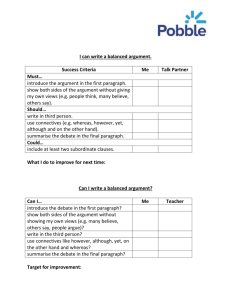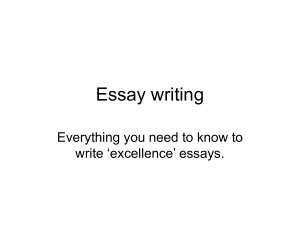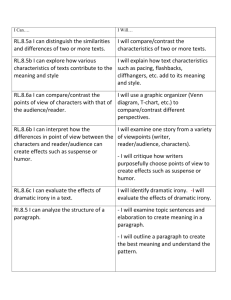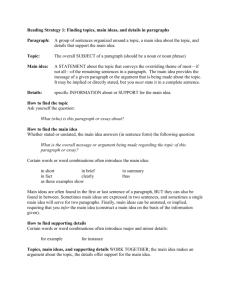Analysis - Critical and Evaluative Reading Made Easy
advertisement
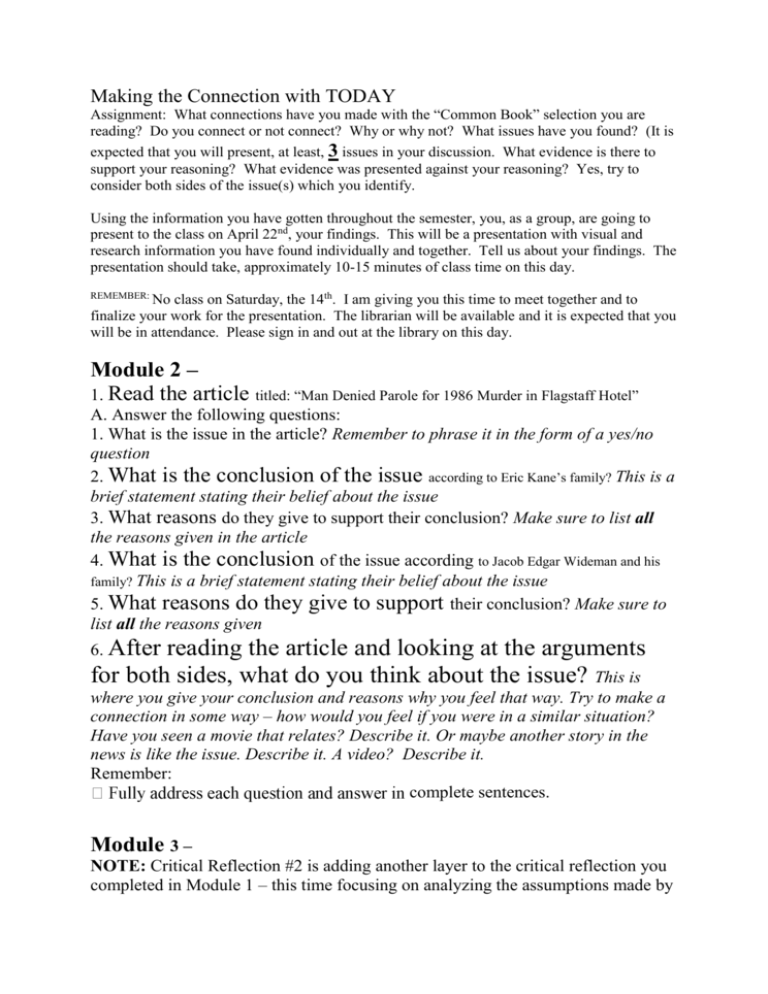
Making the Connection with TODAY Assignment: What connections have you made with the “Common Book” selection you are reading? Do you connect or not connect? Why or why not? What issues have you found? (It is expected that you will present, at least, 3 issues in your discussion. What evidence is there to support your reasoning? What evidence was presented against your reasoning? Yes, try to consider both sides of the issue(s) which you identify. Using the information you have gotten throughout the semester, you, as a group, are going to present to the class on April 22nd, your findings. This will be a presentation with visual and research information you have found individually and together. Tell us about your findings. The presentation should take, approximately 10-15 minutes of class time on this day. REMEMBER: No class on Saturday, the 14th. I am giving you this time to meet together and to finalize your work for the presentation. The librarian will be available and it is expected that you will be in attendance. Please sign in and out at the library on this day. Module 2 – 1. Read the article titled: “Man Denied Parole for 1986 Murder in Flagstaff Hotel” A. Answer the following questions: 1. What is the issue in the article? Remember to phrase it in the form of a yes/no question 2. What is the conclusion of the issue according to Eric Kane’s family? This is a brief statement stating their belief about the issue 3. What reasons do they give to support their conclusion? Make sure to list all the reasons given in the article 4. What is the conclusion of the issue according to Jacob Edgar Wideman and his family? This is a brief statement stating their belief about the issue 5. What reasons do they give to support their conclusion? Make sure to list all the reasons given 6. After reading the article and looking at the arguments for both sides, what do you think about the issue? This is where you give your conclusion and reasons why you feel that way. Try to make a connection in some way – how would you feel if you were in a similar situation? Have you seen a movie that relates? Describe it. Or maybe another story in the news is like the issue. Describe it. A video? Describe it. Remember: complete sentences. Module 3 – NOTE: Critical Reflection #2 is adding another layer to the critical reflection you completed in Module 1 – this time focusing on analyzing the assumptions made by each author. You are, actually, doing a compare/contrast analysis of two authors with differing views... because even though they profess to be…, their value and reality assumptions are very different. These are great to read because you can begin to see that even though people may profess some of the same beliefs, it doesn’t mean they will agree on all issues. I have also divided the questions into three parts: summary, analysis, and response. 1. For each article, answer the following questions: Summary 1. What is the issue in the article? Remember to phrase it in the form of a yes/no question. 2. What is the conclusion of the issue according to the author? This is a brief statement stating their belief about the issue. 3. What reasons do they give to support their conclusion? Make sure to list all the reasons given. Analysis 4. What is an underlying value assumption of the author? Remember, this is how the author believes the world ‘should be’. This is usually inferred from the language used in the article. 5. Do you think many people share this same assumption? Explain your answer. 6. What is an underlying reality assumption of the author? Remember, this is how the author believes the world ‘really is’. This is usually inferred from the language used in the article. 7. Do you think many people share this same assumption? Explain your answer. Then, putting the thoughts of each side together (pro/con) which side has a stronger conclusion? Why? Why not? Module 4 – NOTE: Critical Reflection #3 is adding yet another layer to the critical reflections you completed in Modules 1 & 2 – this time focusing on analyzing the study used as a reason to back up the author’s argument. A CHANGE: I want you to write three short paragraphs for this reflection: a summary, an analysis, and a response. Below I’ve included things that should be included in each of those paragraphs. Notice this is a lot like what you completed in the first two reflections, only now you’re putting everything in paragraph form. REMEMBER: When instructors ask you to read an article and write what you think, this is usually what they’re looking for. We’ll continue to add more as the modules progress. …Answer the following in paragraph form: Summary (Remember: Give the article title and author in the body of the summary to give credit where it’s due, and keep the summary objective. Stay away from value words.) 1. What is the argument and conclusion of the issue according to the author? 2. Explain, in depth, the study that was given in support of the author’s conclusion. Make sure to include sample size, who was involved in the study, who conducted the study, length of study, methods of study and results. 3. Make sure when summarizing that you do not copy and paste directly from the article. You may use short quotes from the article, but the majority of it should be put in your own words. Think of the summary as if you were telling someone who had not read the article about it. Be precise in your telling so the reader can get an accurate picture of the argument and study. Analysis Analyze the study. 1. What are the underlying value assumptions that drove someone to conduct this study? 2. Do you think the study was good enough to support the argument? Why or why not? Think about who took part in the study, the length of the study, and what the participants in the study did. Also, could the researchers be biased toward getting a particular outcome? Remember, this is where critical thinking comes into play. Show me you have understood and can critically respond to what you’ve read. 3. What could have made the study better? More people? Length? Methods? Be specific. 4. Do you think the conclusion (look at the title of the article) of the author who wrote the article is misleading to the reader? Do they read more into the study than even the researchers? What effect could this have on people reading the article and making decisions about lifestyle? Response 5. After reading the article, what do you think about this issue? This is where you give your conclusion and reasons why you feel that way. Think about your own value assumptions and how that might drive your thinking. Try to make a connection in some way – were you or someone you know in a situation related to this issue? Describe it. Or maybe another story in the news is like the issue. Module 5 1. Watch the video on YouTube: British Texting and Driving Video. **This video is under five minutes long. It is GRAPHIC at the beginning. The video was controversial in Europe because it was shown in British high schools. There is no narration in the video, so Summary: the argument must be inferred. *** In a paragraph, share the argument. What is the conclusion of the video, and based on what you saw, what are at least three reasons to they give to support their argument? Remember, these all have to be inferred! Analysis: 1. In a paragraph, explain the video makers' value (how the world should be) and reality assumptions (how the world really is) that drove them to make the video the way they did. Was it effective? Why or why not? Be specific. 2. In another paragraph, share at least two logical fallacies in the video. Give the fallacy and explain the part of the video that showed that particular fallacy. Do you think this was effective? Why or why not? Do the fallacies help or hurt the argument? Why or why not? Response: In a paragraph, share your thoughts on the video. Do you think it's compelling? Should this be shown in the states? Why or why not? What do you think of texting and driving? Should it be illegal? Why or why not? Give reasons and/or examples from the news to support your point.

